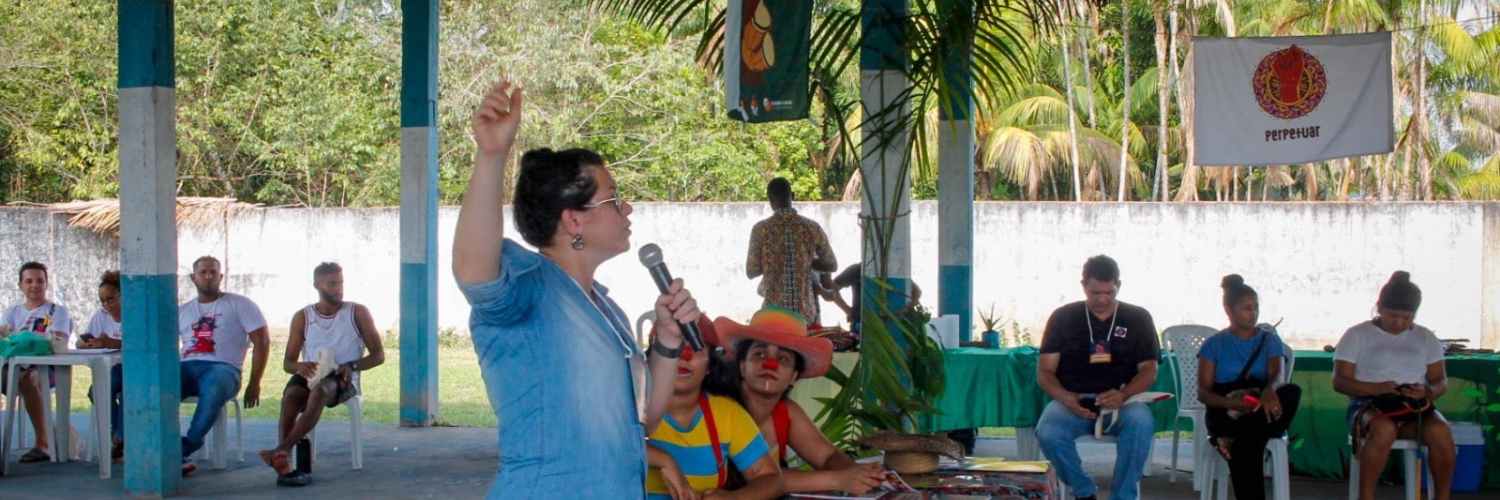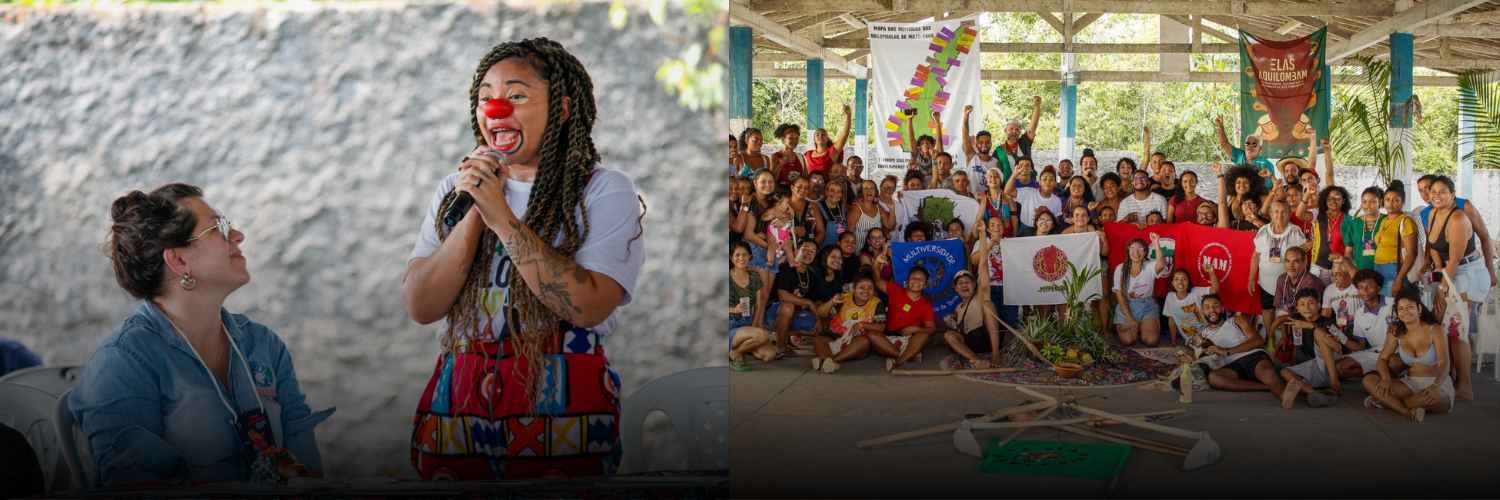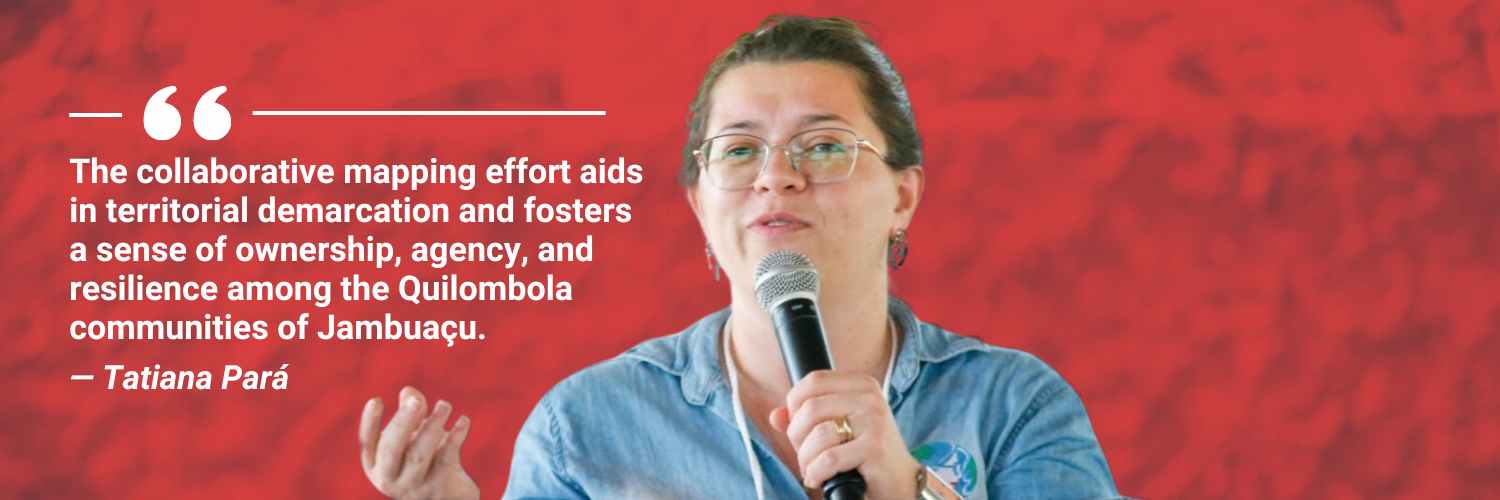News — 02 June, 2024
Meet the Women-Led Mapping Group Enabling Quilombola Communities in the Amazon Through Open Mapping

Meninas da Geo, a women-led mapping group, is enabling Quilombola communities in the Amazon through open mapping. Learn how participatory mapping is strengthening their land rights, promoting sustainable practices, and preserving cultural heritage amidst industrial pressures in Moju-PA, Brazil.
In the region of Moju-PA, Brazil, lie the Quilombolas communities of Jambuaçu. These communities, part of the Northeast Region which houses 69.19% of Brazil’s Quilombolas, are fighting for their land rights against formidable challenges, particularly from the industrial enterprises pressure in the region.
Quilombolas in Brazil are Afro-descendants who live in communities reminiscent of the ancient quilombos (the word for “settlement” in the Angolan language of Kimbundu)—originally formed by people who escaped slavery during the colonial era, and kept African ways of living and culture alive. Known for their agricultural activities, these communities are marked by their ongoing political and territorial struggles.
Recognizing the critical role of mapping for these communities, especially in the ongoing recognition and land titling processes in Pará, the Meninas da Geo (meaning Girls of Geo in English) group has spearheaded remote and collaborative mapping actions in Moju-PA with the support of the Open Mapping Hub in Latin America and the Caribbean (LAC Hub).
In this blog, we had the opportunity to talk to Tatiana Pará, Director of Meninas da Geo. Her work focuses on collaborative mapping in the state of Pará, contributing to the advancement of knowledge and sustainable practices in the Amazon region. She shared insights about the project’s impact and the ongoing efforts to support these communities.
Meninas da Geo: Enabling Women in Geotechnologies
 Photo description: From left to right standing: Isabela, Malu, Mariane, Bianca, Vanessa, Fabiola, Nayara, Thayná, and Gleiciane. From left to right seated: Juliana, Nathália, Tatiana, Marcela, Luciana, and Jessica.
Photo description: From left to right standing: Isabela, Malu, Mariane, Bianca, Vanessa, Fabiola, Nayara, Thayná, and Gleiciane. From left to right seated: Juliana, Nathália, Tatiana, Marcela, Luciana, and Jessica.
Tatiana, a professor at the Federal Institute of Pará (IFPA) in Belém, leads Meninas da Geo. With expertise in Agronomy, Geotechnologies, and Amazon Development, Tatiana focuses on research and community projects.
Founded in 2019, Meninas da Geo has been enabling women for five years by teaching geotechnological skills. They engage in humanitarian mapping and regional activities in the Amazon, connecting with communities and gaining real-world insights. This hands-on approach bridges the gap between academic learning and practical application. Meninas da Geo offers courses, training, project development opportunities, and mapping research across the region.
Beyond training, Meninas da Geo benefits numerous women and communities throughout the Amazon. Members, often from rural areas where family farming is predominant, are strengthened to apply their skills and contribute meaningfully to their communities.
Building a Collaborative Future with the Quilombola Community
 Photo description: Tatiana Pará is presenting the project to community leaders in Moju, Pará.
Photo description: Tatiana Pará is presenting the project to community leaders in Moju, Pará.
Tatiana’s relationship with Moju and the project began in January 2020. Meninas da Geo secured funding, including support from the Ministry of Women, to train in vulnerable regions of Pará, reaching Quilombola areas, indigenous territories, family farmers, and riverine communities. The pandemic limited access to these communities, but dialogue was maintained through 2020 and 2021. In 2022, they resumed in-person activities to understand community needs.
Quilombola communities in Pará, including Moju-PA, face historic struggles for land recognition and titling. They deal with miscegenation, monoculture land repurposing, harassment, and pressure to relinquish their properties, which erodes their cultural characteristics. This often justifies non-titling of their land.
Tatiana said:

Quilombola territories’ invisibility on digital maps weakens their fight for recognition. Financial motives often drive the absence of geographic information, making it easier to falsely claim the land is empty. This hampers recognizing their identity and documenting their history.
The community wanted to understand satellite imagery and recognize their space. They noted their invisibility on maps, even on Google Maps. Meninas da Geo identified and added these roads to the Open Future Maps platform. Working with the LAC Hub and OSM Latin America Community, they mapped the area on the Tasking Manager platform, demonstrating geotechnology is accessible and user-friendly.
Counter-Mapping and Challenging Dominant Mapping Practices
 Photo description: On the right, Tatiana Pará is seen looking at Samilly Valadares, the leader of the Perpetuar Project, both engaged in a focused conversation. On the left, Quilombola community leaders pose with the Meninas da Geo group for a picture.
Photo description: On the right, Tatiana Pará is seen looking at Samilly Valadares, the leader of the Perpetuar Project, both engaged in a focused conversation. On the left, Quilombola community leaders pose with the Meninas da Geo group for a picture.
Counter-cartography enables communities to control their own mapping. As Tatiana explains, “Community leaders decide which routes to map and disclose, and which to keep hidden for security reasons.” Traditional mapping by large entities or AI can overlook these preferences. The project engages freely and consensually with communities, ensuring they manage their information to maintain safety and privacy.
This approach fosters dialogue, respects community boundaries, and aligns technology with their needs and aspirations. It’s about understanding and highlighting the cultural significance of areas. For example, when mapping a forested area, it’s essential to emphasize its importance within the community’s culture and livelihoods. “It’s not just any forest; it’s the backyard of the community.”
The goal is to change the mentality, advocating for the use of accessible tools in various domains. Many are surprised and inspired, saying, “Professor, I had no idea about this.” This highlights how everyday life dynamics often remain hidden in the classroom. People are drawn to the group for its deeper understanding of Pará and its realities, seeing it as a springboard for viewing the region in its true light.
This approach goes beyond standard mapping practices and international norms, reflecting local realities and values. By doing so, communities enable themselves and enhance our understanding of their space, fostering deeper collaboration and reciprocity. This mutual strengthening cultivates stronger bonds and more inclusive, meaningful mapping practices.
Enabling Communities Through Participatory Geospatial Mapping

In essence, the Meninas da Geo group’s work with Quilombola communities in Pará exemplifies how participatory geospatial mapping can drive positive change, allowing communities to control their information and shape their narratives and futures. This initiative is significantly advancing the mapping of Quilombola territories and access roads, enhancing visibility and supporting conservation efforts.
As Tatiana says, “This project goes beyond mere mapping; it aims to enable communities through workshops on mapping platforms and tools. The collaborative mapping effort aids in territorial demarcation and fosters a sense of ownership, agency, and resilience among the Quilombola communities of Jambuaçu.”
Their methodology emphasizes active community engagement, capacity building, and respect for cultural significance. From initial mobilization and workshops to practical exercises and validation processes, every step is designed to be inclusive and participatory. By involving community members, particularly the youth, the Meninas da Geo group ensures the sustainability of their efforts and the continuity of knowledge transfer.

